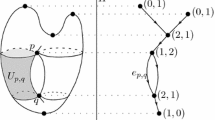Abstract
We study the relation between the symplectomorphism group Symp M of a closed connected symplectic manifold M and the symplectomorphism and diffeomorphism groups Symp \(\widetilde{M}\) and Diff \(\widetilde{M}\) of its one point blow up \(\widetilde{M}\) . There are three main arguments. The first shows that for any oriented M the natural map from \(\pi_1(M)\) to \(\pi_0({\rm Diff}\widetilde{M})\) is often injective. The second argument applies when M is simply connected and detects nontrivial elements in the homotopy group \(\pi_1({\rm Diff}\widetilde{M})\) that persist into the space of self-homotopy equivalences of \(\widetilde{M}\) . Since it uses purely homological arguments, it applies to c-symplectic manifolds (M, a), that is, to manifolds of dimension 2n that support a class \(a\in H^2(M;{\mathbb{R}})\) such that \(a^n\ne 0\) . The third argument uses the symplectic structure on M and detects nontrivial elements in the (higher) homology of BSymp, M using characteristic classes defined by parametric Gromov–Witten invariants. Some results about many point blow ups are also obtained. For example we show that if M is the four-torus with k-fold blow up \(\widetilde{M}_k\) (where k > 0) then \(\pi_1({\rm Diff} \widetilde{M}_k)\) is not generated by the groups \(\pi_1\left({\rm Symp}\, (\widetilde{M}_k, \widetilde{\omega})\right)\) as \(\widetilde{\omega}\) ranges over the set of all symplectic forms on \(\widetilde{M}_k\) .
Similar content being viewed by others
References
Abreu M., McDuff D. (2000). Topology of symplectomorphism groups of rational ruled surfaces, SG/9910057. J. Am. Math. Soc. 13: 971–1009
Baldridge S. (2004). Seiberg–Witten vanishing theorem for S 1-manifolds with fixed points. Pacific J. Math. 217: 1–10
Blanchard A. (1956). Sur les variétés analytiques complexes. Ann. Sci. Ec. Norm. Sup. 73(3): 157–202
Buse O. (2005). Relative family Gromov–Witten invariants and symplectomorphisms, SG/01110313. Pac. J. Math. 218: 315–341
Buse, O.: Whitehead products in symplectomorphism groups and Gromov–Witten invariants, SG/0411108
Gottlieb D. (1965). A certain subgroup of the fundamental group. Am. J. Math. 87: 840–856
Gottlieb, D.: Self coincidence numbers and the fundamental group, AT/0702236
Kȩdra J. (2005). Evaluation fibrations and topology of symplectomorphisms. Proc. Am. Math. Soc 133: 305–312
Kȩdra, J.: Fundamental group of Symp\((M, \omega)\) with no circle action, SG/0502210
Kȩdra J., McDuff D. (2005). Homotopy properties of Hamiltonian group actions. Geom. Topol. 9: 121–162
Lalonde F., McDuff D. (1996). The classification of ruled symplectic 4-manifolds. Math. Res. Lett. 3: 769–778
Lalonde, F., McDuff, D.: Symplectic structures on fiber bundles, SG/0010275. Topology 42, 309–347 (2003). Erratum Topology 44, 1301–1303 (2005)
Lalonde F., Pinsonnault M. (2004). The topology of the space of symplectic balls in rational 4-manifolds, SG/0207096. Duke Math. J. 122: 347–397
Lalonde F., McDuff D., Polterovich L. (1999). Topological rigidity of Hamiltonian loops and quantum homology. Invent. Math. 135: 369–385
Le, H.V., Ono, K.: Parameterized Gromov–Witten invariants and topology of symplectomorphism groups, preprint #28, MPIM Leipzig (2001), revised version SG/0704.3899
Lerman E. (1995). Symplectic cuts. Math. Res. Lett. 2: 247–58
Li B.-H. (1999). Representing nonnegative homology classes of \({\mathbb{C}}P^2\#n\overline{{\mathbb{C}}P}^2\) by minimal genus smooth embeddings. Trans. Am. Math. Soc. 352: 4155–4169
Li T.-J. (1999). Smoothly embedded spheres in symplectic 4-manifolds. Proc. Am. Math. Soc 127: 609–613
Li, J., Tian, G.: Virtual moduli cycles and Gromov–Witten invariants for general symplectic manifolds. Topics in Symplectic 4-manifolds (Irvine CA 1996), pp. 47–83. Internat. Press, Cambridge, MA (1998)
McDuff D. (1990). The structure of rational and ruled symplectic 4-manifolds. J. Am. Math. Soc 3: 679–712 Erratum J Am Math Soc 5987988
McDuff, D.: From symplectic deformation to isotopy. In: Topics in Symplectic 4-manifolds (Irvine CA 1996), pp. 85–99 Internat. Press, Cambridge, MA (1998)
McDuff D. (2005). Enlarging the Hamiltonian group, SG/0503268. J. Symplect. Geom. 3: 481–530
McDuff, D., Salamon, D.A.: J-holomorphic Curves and Symplectic Topology. Colloquium Publications 52, American Mathematical Society, Providence, RI (2004)
Pinsonnault, M.: Symplectomorphism groups and embeddings of balls into rational ruled surfaces. Compositio. Math. SG/0603310
Ruan Y. (1993). Symplectic topology and extremal rays. Geom. Funkt. Anal. 3: 395–430
Seidel P. (1999). On the group of symplectic automorphisms of \({\mathbb{C}}P^m\times {\mathbb{C}}P^n\). Am. Math. Soc. Transl. 196(2): 237–250
Seidel, P.: Lectures on four dimensional Dehn twists, SG/0309012
Taubes C.H. (1994). The Seiberg–Witten invariants and symplectic forms. Math. Res. Lett. 1: 809–822
Zinger, A.: Pseudocycles and Integral Homology, AT/0605535
Author information
Authors and Affiliations
Corresponding author
Additional information
Partially supported by NSF grants DMS 0305939 and 0604769.
Rights and permissions
About this article
Cite this article
McDuff, D. The symplectomorphism group of a blow up. Geom Dedicata 132, 1–29 (2008). https://doi.org/10.1007/s10711-007-9175-3
Received:
Accepted:
Published:
Issue Date:
DOI: https://doi.org/10.1007/s10711-007-9175-3
Keywords
- Symplectomorphism group
- Diffeomorphism group
- Symplectic blow up
- Parametric Gromov–Witten invariants
- Symplectic characteristic classes



